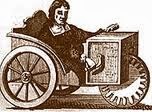Happy Disability History Week! To celebrate this week, we will be highlighting the history of a few different AT devices.

No one knows exactly when the first wheelchair was invented, however its origins date back to ancient times. The earliest records of a wheeled transportation device were found in a stone carving in China and an image on a Greek vase of a wheeled child’s bed. The first known wheelchair purposefully designed for disability and mobility was called an “invalid’s chair”. It was invented in 1595 specifically for King Phillip II of Spain. The chair had small wheels attached to the end of a chair’s legs and it included a platform for Phillip’s legs and an adjustable backrest. It could not be self-propelled but most likely the King always had servants transporting him around.

In 1783, John Dawson of Bath, England invented a wheelchair and named it after his town. The Bath wheelchair had two large wheels in the back and one small one in the front. The user would steer the chair by a stiff handle, but all the Bath designs had to be pushed or pulled by a donkey or horse, as they were heavy. The Bath wheelchair did outsell all other models of wheelchairs for 40 years.

Steven Farffler
Skipping forward to 1655, Steven Farffler was a young German watchmaker with a disability that limited his mobility. He is the first known person to invent and use a wheelchair that could be independently propelled. It was a stable chair mounted on a 3-wheeled chassis with attached handles on both sides of the front wheel used to propel the chair forward. Mr. Farffler, who is believed to have had paraplegia, created the wheelchair himself when he was only 22 years old!
Then, in the 1800s, the first wheelchairs that are more similar to today’s designs were developed. In 1869 a patent was taken out on a wheelchair that could be self-propelled and had large wheels at the back. Wheelchairs were starting to get less bulky but still were not easily transportable until 1932 when the folding tubular steel version was made by Harry Jennings. Harry Jennings was an engineer that designed it for his friend, Herbert Everest. Together they founded Everest and Jennings company, which had a monopoly on the wheelchair industry for decades.
Electric-powered wheelchairs were invented by George Klein and others to assist injured veterans after WWII. As you know, designs from then have consistently improved in size, weight and to adapt to an individual’s needs. They are even currently developing a new “iBot type chair“ (the former iBot chair is currently discontinued and was extremely expensive) that can rise up on to two wheels, walk up and down stairs, traverse sand, gravel and water and cannot be easily flipped over. Some speculate that in the future wheelchairs will be able to be controlled by neurological impulses from the brain. What do you think wheelchairs will look like in the future? Tell us your ideas in the comment box below.





